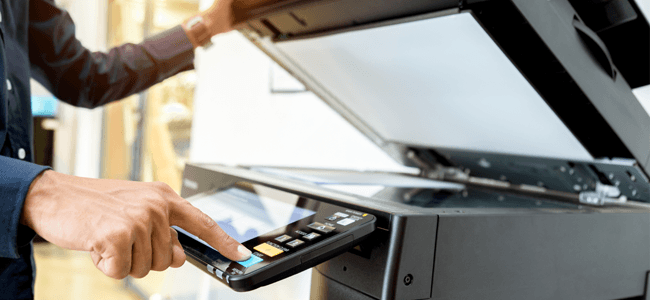
MANAGED PRINT SERVICES | 6 MIN READ
Since the 1980's when electronic document management systems arose to begin replacing paper-based systems, many firms have made the switch in order to garner the advantage of managed print. These new software systems are much more efficient, secure, and compliant with regulations than are physical- based systems. Keep reading to learn how managed print services and document management systems can reduce paper usage in your office.
Not enough time? Jump to:
What are Managed Print Services?
Benefits of Managed Print Services
What is a Document Management System?
Benefits of Document Management Systems
Other Tips to Reduce Paper in the Office
The push for companies to become more environmentally friendly and the constant drive to reduce spending and cut waste means that many are searching for ways to reduce or eliminate paper usage in the office.
While you can, for instance, take paper out of your invoicing or sales processes, meetings, and marketing efforts, there are still many ways in which companies still have printing needs. For instance, important documents may still be required to be sent and delivered by mail.
Those in print-heavy industries, for instance legal and education, especially may find it difficult to completely make the transition to a paperless work environment.
While going entirely paperless may be a stretch for some companies, reducing paper usage as much as possible is within the realm of possibility for every company.
Both managed print services and document management systems give businesses the opportunity to reduce paper usage in their workplace, therefore reducing strain on their wallets and the environment.
What are Managed Print Services?

Managed print services are the third-party full-service support of your printer fleet. These services, when done correctly, reduce overhead and cut costs on toner, machine parts, and labor.
Your Printers Today
Many people don't realize how expensive it is to print using printer cartridges. Printer manufacturers stay in business because of the profits they make on cartridge replacements.
If I go online right now to one of the major brand name office supply companies, I will find an HP Laserjet Pro Cartridge for $76. According to its box, this cartridge will give me 1,600 pages of printing. That's $0.475 per page!
Now, fifty cents per page isn't much if you're only printing 100 pages per month, but companies printing a sizable amount of jobs per month need to evaluate what these costs would be over time.
On the other hand, when you use managed print services through a copier or printer dealer, they can get the prices below a penny per page. This would mean a 50% reduction in your printing costs based on cartridges alone.
RELATED: How Much Do Printers Really Cost?
How Do Managed Print Services Work?
As a managed print services provider, we assist businesses every day by creating more efficient uses of client resources through the latest printing technology. We do this by using software to collect data on each copier and multifunction printer in a company's office.
Software like FMAudit allows your vendor to monitor your volumes by department (and even by user), as well as the type of printing that is being done (ex. black & white vs color) on any network-connected device.
This data allows us to analyze the complete cost, volume, performance, and utilization of each device. Then, our experts can make the most accurate recommendation possible on the best printing strategy for each business. Simply put, managed print services are the management and analysis of all multifunction devices assigned to a given location.
Imagine the ability to be able to know which department is using the most printing or being able to more appropriately assign department printing budgets. Keep in mind, however, that just because a department isn’t printing large quantities doesn’t mean they are automatically printing efficiently.
RELATED: What are Managed Print Services?
Benefits of Managed Print Services
Features
Automatic Toner Replenishment
A managed print services provider can automatically notify you of issues such as when specific printers are running low on toner. At some companies, this is called an auto-toner replenishment program.
This ensures that your business operations are never halted because your printer is out of toner.
Printer Optimization
To reduce your printing costs, managed print services can optimize the location of machines throughout your office and enable features that help employees print efficiently.
For instance, a managed print services provider can evaluate which departments print the most and designate printers built for speed and high print volume to those areas.
By enabling features such as Find Me Follow Me on your printers, a managed print services provider can prevent employees from accidentally forgetting documents in the print tray, which ultimately leads to print waste.
Features can also be enabled that redirect print jobs to more efficient machines, and rules can be created that restrict the amount of color printing.
Printer Policy Implementation
A managed print services provider can assist your company in building a printer policy to minimize employee paper waste, establish guidelines for two-sided and color printing, and more.
They can also use printer data to determine which departments are using the most paper so recommendations can be made accordingly on a departmental basis, such as setting rules to restrict which printers employees can use.
Track Service/Maintenance History
While a managed print services provider can lower printing costs and paper waste by enabling features on your machines and educating employees on printing best practices, they can also reduce costs by tracking service and maintenance history for your printers.
By tracking this, you can, over time, begin to recognize patterns and identify which machines are costing more to fix than they're worth. This can show you which machines should be replaced if you wish to keep only the most efficient machines.
Expert Technological Recommendations
Older machines and cheaper models alike become cost-ineffective over time as parts wear out. This can mean that your machines start printing documents more slowly or incorrectly.
While your managed print services provider can make some data-based recommendations about printer features to enable or machine placement within your office, sometimes the best recommendation they can give is to get a new printer altogether.
Benefits
Cost Reduction
The most obvious benefit to managed print services is the cost reduction it offers to your business.
By providing you lower prices for ink and toner, enabling certain features on your machines, educating employees on printing best practices, and using machine data to make technological recommendations, your managed print services provider can streamline printing processes and reduce costs for supplies and printer maintenance.
Productivity
When machines don't print efficiently, for instance if you unknowingly keep around old dysfunctional machines, workplace downtime increases.
A managed print services provider can identify inefficient machines in need of replacement and set notifications for low toner for those you wish to keep around, which all keep your machines working and minimizes the hindrance employees experience having to work around broken printers.
Environmental Friendliness
When a managed print services provider keeps machines running smoothly and minimizes paper waste within your office, Mother Nature is happy as well.
A non-monetary benefit to managed print services is the reduced environmental strain. Employee printing policies are the biggest factor in fostering an environmentally friendly workplace attitude in your office, so be sure to craft a descriptive printing policy if this is a benefit you really wish to dive into.
RELATED: Benefits of Managed Print Services
What is a Document Management System?

Document management, often referred to as Document Management Systems (DMS), uses software to store, organize, and track electronic documents.
Document management systems, which are sometimes cloud-based, are employed by businesses to streamline business operations while transitioning to a paperless environment.
Paper files are typically uploaded to the system via a document scanner, where they are then stored. Converting paper files to digital versions can eliminate the need for file cabinets while better ensuring the security of said files.
RELATED: Document Management System Features [Top 6]
Benefits of Electronic Document Management Systems
Workplace Efficiency
Instead of having to find files that are stored in multiple old-school filing cabinets or in a variety of areas both online and offline, having all files in one centralized hub allows for increased efficiency.
Remote Office Capabilities
By being able to access files online and from multiple devices, employees aren't tethered to the office as much.
They can access files whenever and wherever they want, allowing them to work on their own schedule.
Increased Productivity
Imagine all the time employees waste looking for files that are buried in unorganized folders, or files that must be copied and switched around in order for all team members to find them.
With a document management system, employees can find files faster through various search functions, which means there is less wasted time in the workday.
Data Privacy Compliance
Workplace Efficiency
Instead of having to find files that are stored in multiple old-school filing cabinets or in a variety of areas both online and offline, having all files in one centralized hub allows for increased efficiency.
Remote Office Capabilities
By being able to access files online and from multiple devices, employees aren't tethered to the office as much.
They can access files whenever and wherever they want, allowing them to work on their own schedule.
Increased Productivity
Imagine all the time employees waste looking for files that are buried in unorganized folders, or files that must be copied and switched around in order for all team members to find them.
With a document management system, employees can find files faster through various search functions, which means there is less wasted time in the workday.
Data Privacy Compliance
If an unauthorized person were to access private company files, your company could be in violation of data privacy regulations such as HIPAA. This could lead to lawsuits, financial penalties, and other punishments.
Setting permission levels for files allows businesses to restrict file access to only specific people, which minimizes the risk of data privacy law violations.
RELATED: Can Businesses Be Sued for Data Breaches?
Disaster-Proof Documents
If your business were to experience a network outage tomorrow, whether it's from a natural disaster or ransomware attack, the potential data loss you could experience could be severe.
When files are backed up automatically to a document management system, this means that files can still be accessed and work can continue even when your network goes down.
If an unauthorized person were to access private company files, your company could be in violation of data privacy regulations such as HIPAA. This could lead to lawsuits, financial penalties, and other punishments.
Setting permission levels for files allows businesses to restrict file access to only specific people, which minimizes the risk of data privacy law violations.
RELATED: Can Businesses Be Sued for Data Breaches?
Disaster-Proof Documents
If your business were to experience a network outage tomorrow, whether it's from a natural disaster or ransomware attack, the potential data loss you could experience could be severe.
When files are backed up automatically to a document management system, this means that files can still be accessed and work can continue even when your network goes down.
Other Tips to Reduce Paper in the Office
Consider Multifunction Printers

While it sounds counter intuitive to use a printer to reduce office paper usage, there are certain settings on a multifunction printer that can be used to limit paper waste.
Multifunction printers have many settings that can reduce the amount of paper used for a print job. Enabling simple settings like two-sided printing for all print jobs can cut the amount of paper you use in half.
Also, by enabling the Find Me, Follow Me feature on your printer whenever possible, you can reduce the amount of forgotten about prints that contribute to paper waste.
With this feature, when you send a print job to a printer, that printer does not begin printing until you walk over to the printer and manually release the print job. This feature is beneficial for employees who, without this feature, may send print jobs to the printer and forget to pick them up.
This feature is also beneficial for file security as well. When sensitive files are sent to a printer and are not picked up, those printed documents sit in the paper tray for anyone walking by to pick up. For those who are subject to data privacy regulations, this feature can help keep you compliant by reducing the risk of data breaches.
RELATED: How Can Your Printers Have Security Risks? [Tips to Protect]
Encourage Environmental Friendliness
While using recycling bins to encourage employees to be more environmentally friendly can reduce the amount of paper that ends up in a landfill, there are other ways to use recycling ideas to reduce paper usage and cut costs in your office.
For instance, you can use scrap shredded paper from non-sensitive documents to make package fillers. This can especially save money if your company ships a lot of packages.
Additionally, by encouraging employees to work digitally whenever possible, you can reduce the amount of scrap paper in your office. For instance, instead of employees constantly using sticky notes and printer paper for note-taking and reminders, encourage them to use digital sticky notes or take notes in Microsoft Word or other digital document systems.
You can even take this idea of workplace environmental friendliness one step further by encouraging employees to bring reusable water bottles and food containers to work. This will reduce the amount of paper plates and disposable utensils that you'll need to buy for the break room.
Fostering a culture of environmental stewardship within your organization will make each employee united in the effort to reduce paper usage in your office.
Use Environmentally Friendly Shipping and Packaging
Think about all the mail your company ships and receives. The amount of paper envelopes and documents you send and receive can add up quickly, contributing to excess paper usage and a build-up of paper costs.
Consider purchasing products with less packaging or with no packaging at all. This may cost a little more money up-front but could save you money in the long run.
If you request that your office deliveries be shipped in returnable containers, you can return the emptied containers back to the supplier.
Finally, consider evaluating your current business processes to see what can be shifted to a fully digital format. For instance, with a little extra effort, maybe you could convert files to a digital format so they don't need to be shipped.
Managed print services and document management systems are two great ways to reduce paper usage in your office.
If you're a Georgia-based company interested in reducing your paper usage, contact us today so we can help get you started.
Posted by Daniel Gray

Daniel has a passion for educating and helping people and has spent over a decade in the education and office technology industries. He has a Bachelor's in Education from the University of West Georgia and an MBA from the University of Georgia. Daniel has been the lead writer at SOS since 2017 and specializes in managed IT services, copiers and printers, and business phone systems. He lives in Atlanta and has a goofy greyhound named Ticker.


